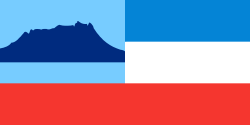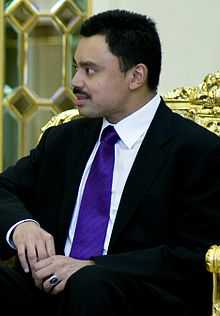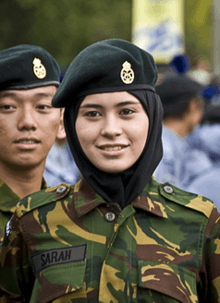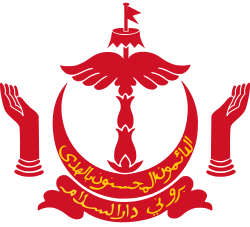Bruneian Malay people
Bruneian Malay|
|
| Total population |
|---|
|
Est. 330,000[1] (1999 estimate) |
| Regions with significant populations |
|---|
|
 Brunei Brunei
 Malaysia Malaysia
Sarawak (Kuching, Lawas, Limbang, Miri)
Sabah (Beaufort, Kimanis, Kota Kinabalu, Papar)
Labuan |
| Languages |
|---|
|
Malay, Bruneian, English, Brunei English |
| Religion |
|---|
|
Shafi'i Sunni Muslim |
| Related ethnic groups |
|---|
|
Demographics of Brunei, Malay |
Bruneian Malays[note 1] (Malay: Orang Melayu Brunei, Jawi: اورڠ ملايو بروني) are a native ethnic group that live in Brunei, Sabah, and Sarawak.[2][3] The Bruneian Malays are different from the larger Malay population in the Peninsular Malaysia especially in language and culture, even though they are ethnically related and follow the teachings of Islam.[4] All Bruneian Malays who are born in Malaysia since before the formation of Malaysia were in the same status like the Malays and recognised as a Bumiputeras together with Kadazan-Dusuns, Ibans, Malaccan Portuguese and the Malaysian Siamese.
Etymology
As per an official statistics, the "Bruneian Malays" term only became official after the 1921 Brunei Ethnic Categories Census, which is different from the 1906 and 1911 census which only mentioned "Barunays" (Brunei's or Bruneian). It is possibly indicated a shift on the self-perception by the Bruneians about their Malay identity.[5]
History
Origin
It is widely believed that the Brunei Kingdom was founded in 14th century by the first Sultan, Alak
Batatar.[5] However, from the Chinese records, an older Brunei was in existence as far back as 800 years before the founding of Brunei by Sultan Muhammad Shah, the first Sultan of Brunei.[6] Even though some sources stated that the Malays of Brunei came from Yunnan and the Formosa Island (now Taiwan) through to the Philippines and settled on the coastal Borneo before expanding into Sumatra and the other Malay Peninsula as a result of their trading and seafaring way of life, researchers still unable to traced the origin of the old Brunei.[6]
Cultures
Cuisine
As the official Brunei national dish, the Ambuyat is the main dishes for the Bruneian Malays together with a numbers of variety types of snacks such as lamban, punjung and many more.[7][8]
Music
The main song and dance performed by this ethnic both in Brunei and Malaysia is the Adai-adai,[9][10] which traditionally sung by the Bruneian fishermens.[11][12]
See also
References
- ↑ Adrian Clynes. "Occasional Papers in Language Studies, Department of English Language and Applied Linguistics, Universiti Brunei Darussalam, Volume 7 (2001), pp. 11-43. (Brunei Malay: An Overview1)" (PDF). Universiti Brunei Darussalam. Retrieved 21 August 2013.
- ↑ "The Malay of Malaysia". Bethany World Prayer Center. 1997. Retrieved 23 August 2013.
- ↑ "The Diaspora Malay". Bethany World Prayer Center. 1997. Retrieved 23 August 2013.
- ↑ Ibp Usa; International Business Publications, USA (7 February 2007). Brunei Sultan Haji Hassanal Bolkiah Muizzaddin Waddaulah Handbook. Int'l Business Publications. pp. 34–. ISBN 978-1-4330-0444-5.
- ↑ 5.0 5.1 B. A. Hussainmiya (2010). "The Malay Identity in Brunei Darussalam and Sri Lanka" (PDF) 10. Universiti Brunei Darussalam. pp. 67, 68 and 69/3, 4 and 5. Retrieved 29 October 2014.
- ↑ 6.0 6.1 Rozan Yunos (25 October 2010). "The Malay origin: Tracing back the lineage of the old Brunei". The Brunei Times. Archived from the original on 29 October 2014. Retrieved 29 October 2014.
- ↑ Jessica Tiah (8 January 2011). "Ambuyat - Our iconic heritage". The Brunei Times. Archived from the original on 5 April 2014. Retrieved 5 April 2014.
- ↑ Zaimah Dinin (4 April 2014). "Ambuyat, kelupis pelik tapi sedap" (in Malay). Sinar Harian. Archived from the original on 29 October 2014. Retrieved 29 October 2014.
- ↑ Culture Grams. CultureGrams. 2010.
- ↑ "Papar Culture (Brunei)" (in Malay). Papar District Office. Archived from the original on 29 October 2014. Retrieved 29 October 2014.
- ↑ Marshall Cavendish Corporation (2007). World and Its Peoples: Malaysia, Philippines, Singapore, and Brunei. Marshall Cavendish. pp. 1202–. ISBN 978-0-7614-7642-9.
- ↑ Lonely Planet, (2010). The Travel Book: A Journey Through Every Country in the World. Lonely Planet. pp. 63–. ISBN 978-1-74179-211-9.
Notes
- ↑ Brunei Malay in its various forms can be identified with a nation, an ethnic group, and a
region.
Books
- Laporan banchi pendudok Brunei, 1971 (Bahagian Ekonomi dan Perangkaan, Jabatan Setia Usaha Kerajaan), 1971.
- Mohd. Nor bin Long; Perkembangan pelajaran di Sabah (Dewan Bahasa dan Pustaka, Kementerian Pelajaran Malaysia), 1978.
- Sabihah Osman, Muhamad Hadi Abdullah, Sabullah Hj. Hakip; Sejarah Brunei menjelang kemerdekaan (Dewan Bahasa dan Pustaka, Kementerian Pendidikan Malaysia), 1955.
| Related articles |
|---|
|
 Recognised ethnic groups in Labuan |
|---|
| | Ethnic groups | |
|---|
|
 Recognised ethnic groups in Sabah |
|---|
| | Ethnic groups | |
|---|
|
 Recognised ethnic groups in Sarawak |
|---|
| | Ethnic groups | |
|---|
|
|
|







